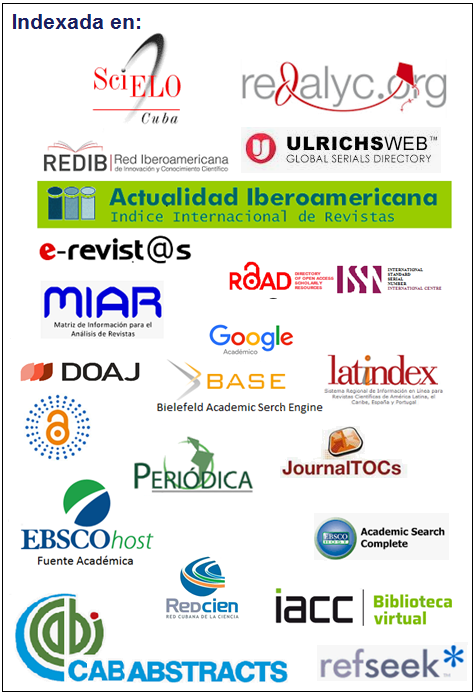Effect of mining rehabilitation with an economic and socio-environmental approach in Moa, Cuba
Keywords:
mining rehabilitation, sustainable mining, economic valuation, lateritic deposits, degradation of ecosystemsAbstract
Mining rehabilitation is essential in any sustainable mining project. This study was aimed at evaluating the application of a mining rehabilitation procedure that considers the social, economic, and environmental dimensions in open-pit mining of lateritic weathering crust deposits in Moa. For this purpose results of indicators of the new procedure in 2020 and results prior to the implementation of such procedure were compared. It was obtained that the economic efficiency of mining rehabilitation process was 74.82% in 2019 in contrast to 2020 where the efficiency was 100%; expenses in gullies correction were reduced by 191,913.86 pesos and a saving of 36,000.89 CUC was achieved in the process of intercropping the casuarina tree with other species (guava and cashew)Downloads
References
Marín-Marín, N. 2012: Modelos de recuperación de áreas degradadas por minería de oro de aluvión. Simposio bosques y minería responsable, Centro Información Ambiental (CIA) Sede Central, pp. 1- 46.
Matos, J. 2004: Propuesta metodológica para llevar a cabo la restauración de ecosistema degradados. [en línea] [fecha de consulta 10 de diciembre de 2019] Disponible en: www.idia.org.do
Palacios-Castillo, G. 2018: Comportamiento de las estrategias de manejo forestal y de conservación, en la minería de níquel, Moa, Holguín, Cuba. IV Congreso Internacional de Minería y Metalurgia, La Habana, pp 55.
Petronzi, A.; Pirazzini, C.; Lancellotti, L. Listado de precio animal. Italia. [en línea] [fecha de consulta el 22 de enero de 2020]. Disponible en: http://www.shellauction.net
Reynaldo-Argüelles, C.L. 2013: Procedimiento para la valoración económica y ambiental en la actividad minera de níquel [en línea]. Tesis doctoral, Santiago de Cuba. [Consultado 13 de enero de 2019] Disponible en: http://www.ismm.edu.cu/edum
SENDECO2. Precios del CO2. [en línea] [fecha de consulta 28 de diciembre de 2019]. Disponible en: https://www.sendeco2.com/es/precios-co2
Serrada-Hierro, R. 2000: Apuntes de Repoblaciones Forestales. FUCOVASA. Madrid, pp. 1-77.
Torres-Batista, Y., Rodríguez-Córdova, R. G., y Reynaldo-Argüelles, C. L. 2019:. Propuesta de un procedimiento para la rehabilitación minera en explotaciones a cielo abierto. Revista: Minería y Geología, 35(1): 17-30.
Triton. Listado actualizado de animales. [en línea] [fecha de consulta 22 de enero de 2019]. Disponibles. en: http://www.tritonreptiles.com
UNESCO. 2012: Education for Sustainable Development Sourcebook [en línea]. París Francia: Organización de las Naciones Unidas para la Educación, la Ciencia y la Cultura. [consultado: 8 de septiembre de 2018] ISBN 978-92-3-001077-5. Disponible en: http://unesdoc.unesco.org
Urbino Rodríguez, J., Díaz Martínez, B., y Sigarreta Vilches, S. 2019: Rehabilitación ambiental minera. Villa Clara. Cuba. Editorial Feijóo, pp. 1-377. ISBN: 978-959-312-267-2
Published
How to Cite
Issue
Section
- Authors retain copyright and guaranteeing the right magazine to be the first publication of the work as licensed under a Creative Commons Attribution-NonCommercial that allows others to share the work with an acknowledgment of the work's authorship and initial publication in this journal.
- Authors may establish separate supplemental agreements for the exclusive distribution version of the work published in the journal (eg, place it in an institutional repository or publish it in a book), with an acknowledgment of its initial publication in this journal.
- Authors are allowed and recommended to disseminate their work through the Internet (e.g., in institutional telematic archives or on their websites) before and during the submission process, which can produce interesting exchanges and increase citations of the published work. (See The effect of open access)




